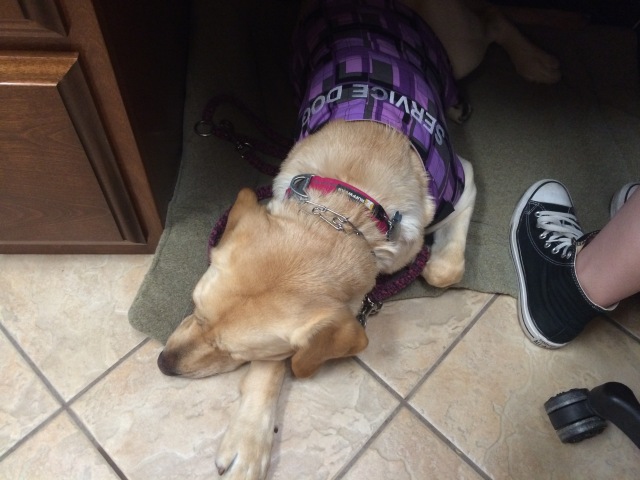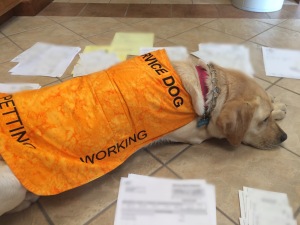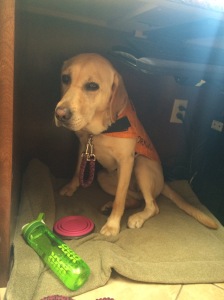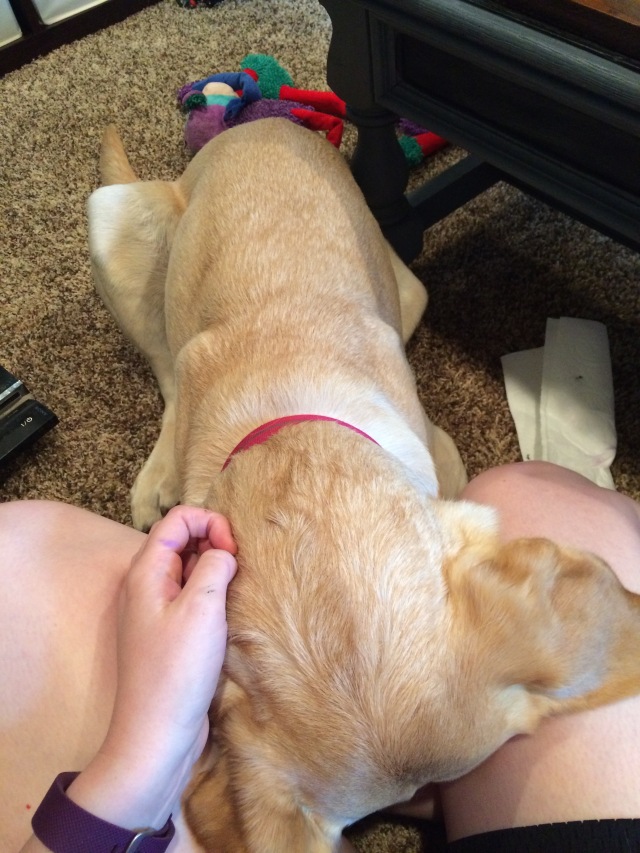
A while ago, I was asked a question about making a dog a service dog. The person meant well so as I was explaining the process, others started listening in and I realized something. There is a huge misconception about what a service dog is, does and how they come to be. So this is my best attempt at explaining.

Not a service dog
If you look up Service dog on the internet, 6 of the 8 sites that come up are about registering your dog as a service dog and taking your dog everywhere. It makes it seem like all you need to have a service “dog” is a decently trained pet (apparently the term dog can mean bird, snake, cat, turkey ect), some money, and abracadabra, your animal can go anywhere. Some of these sites are free, but most cost anywhere from $25-$150 for a service animal packet. Once this process is complete, most people think they are free to take their beloved pet anywhere they want. Sadly, these people are breaking the law. And while some realize it, others do not. Once again this is illegal and is not how you “get” a service dog.

Service Dog
Some where along the way people have forgotten that service dogs have a specific purpose and are considered medical equipment. They simply want to take their pet with them because it’s “fun”. Now do not get me wrong, I love having Bella but if leaving her home meant I didn’t have a disability I would. When someone asks my about “getting” a service dog my first statement always sounds harsh. “In order to qualify for a service animal you must be legally disabled according to your doctor, are you?” I feel bad when I say this, because I sound judgy or noisy but it has to be said and the answer determines how the rest of the conversation goes. Plus if they are really planning on getting a service dog, that will be the least invasive of questions they will face.
Definitions (I know ugh wiki but it was easy to find)
Disabled: physically or mentally impaired in a way that substantially limits activity especially in relation to employment or education (Merriam Webster Dictionary)
Disability: is the consequence of an impairment that may be physical, cognitive, intellectual, mental, sensory, developmental, or some combination of these that results in restrictions on an individual’s ability to participate in what is considered “normal” in their everyday society. A disability may be present from birth or occur during a person’s lifetime. (Wikipedia)
Let me be pretty clear about this, if you are not disabled you cannot have a service dog. It doesn’t matter how well-behaved they are or how much you pay online, you can not have a service dog. Period. There are many illnesses that qualify as disabilities but just because you have anxiety or depression or diabetes or something else does not mean you are disabled and qualify for a service dog. I know many people with illnesses that can function in life just fine.
I got on a soap-box rant for a minute and had to take a step back. But now I am focused. This topic is just very important to me.

Not being helpful at the moment but still a service dog
Things that make a service dog:
- Handler must have a disability.
- Being a self-diagnosed or a convenient disabled does not count. Why people think being disabled is convenient for the so-called “perks” is baffling to me.
- The disability can be either visible or invisible
- Dog must be task trained to mitigate said disability for that person.
- Let me say that again, TASK TRAINED to that SPECIFIC person.
- Dog must be well-behaved to the max. While dogs are still dogs, and they have off days, a service Dog should be on point 95% of the time.
- Most service dogs go through months or years of training before receiving the title of “Service Dog”.
- The animal must be a dog or can be a miniature pony in some states.
- That means no you can not have a service turkey or monkey or lizard or pig, contrary to what the media or scam sites may say.
- Although sometimes I call my husband a Service Parrott he is not actually a bird so I am not breaking any laws.
- Clarification: some people do not use service animals and instead use nurses or have family help them with their disabilities. I (sometimes others in the community) call them service people.

Still not a service dog
Things that do not make a service dog
- A fluffy cute dog you want to take places.
- This means whether it is trained or untrained it does not count.
- A dog that comforts you or makes you feel better as his only “task”
- According to the ADA Comfort does not qualify as a task and there for does not make a dog a service dog.
- Any form of Certification or identification off of the internet.
- Just no.

Bella is not amused by fake service animals
Just so people can understand I am going to tell you how Bella and I meet the requirements:
- I am legally disabled according to my doctor. I have severe depression, panic and anxiety disorder, Bipolar and debilitating migraines. The level of my illnesses qualifies me because it prevents me from performing normal every day life tasks.
- Bella is task trained to me.
- She alerts to anxiety and panic attacks
- She performs preventative tasks such as block, grounding and Deep pressure therapy (DPT)
- She performs responsive tasks like guiding to a safe place, or finding help.
- Those are just a few of her tasks
- Bella went through a 1.3 years of training before I got her then we continued to train up until she turned 2 and we still practice training on a regular basis to keep her at a working level.
- Yes she is a dog, although sometimes she thinks she’s a “hooman”

Poor example, but Bella attempting a grounding task while being lazy
I realize this post got lengthy and soap-boxy but I am very passionate about this topic. If done right, service dogs are amazing medical tools that can change a person’s life. If done incorrectly, your fake service dog could change my life for the worst by interfering with my service dog. Fake SD’s cause access issues for handlers and can give service dogs a bad name. When “fluffy” walks in, pees on the floor, bites a store employee that tries to clean up and then the “handler” flashes an ID and says “you cant kick me out”, stores are more likely to challenge real handlers and try to keep them our of their stores. It’s a harsh reality that happens often.
So please, make sure you follow the rules if you are getting a service dog and Please for the love of all that is good, do not fake a service dog so you can take “fluffy” with you.

Thank you for your post! My daughter is disabled and we are looking into programs to find medical service dogs for her and we are also considering finding medical service dogs for my husband and I since we both are diabetic and need assistance with it. I have been checking into programs and have had a very hard time locating any that train or even teach me to train (I am very interested in learning how to train to help others as well as my family) I am considering training one of my 2 chihuahuas for diabetic training because his personality fits the criteria, but can’t find anything on the actual training..I have purchased books to help, and have contacted many training placrs, but none are in my area. Any ideas on who is legal and how to distinguish the bad ones from the news ones? I am perfectly capable of doING the training, but can’t find the “correct training” for diabetes or physical disability training. Any help would be greatly appreciated since I seem to get the run-around from almost every company I contact.
Hi! Thank you for your story. Part of the run around could be that you’re looking for three service dogs or trying to train a current pet. Diabetic alert dogs need extensive scent training starting when they are a pup. I know there is a place in Kansas City with a good reputation. Otherwise I would almost recommend working closely with a local personal trainer if you can’t find a group. Since it would be your first service training I don’t know if I recommend owner training yet because it is complicated but to each his own. Good luck!
I’m in the process of training my 10 month old rescue pup to be my PSD.
I live in the UK, there are no PSDs here. We also don’t have ESA. I’ve contacted close to a dozen places over the past 5 years, but in the UK there is no service that will match / train SD for handlers with psychiatric disabilities – physical ones, yep, autism in kids, sure…but no service / assistance dogs for mental illnesses.
I have Bipolar 1, GAD, MDD, constant psychosis and non-epileptic seizures. It wasn’t until we noticed Pixie alerting to the seizures (sometimes 10 mins before they happened) and that her licking and nudging when I was coming around helped, that we thought to train her as a PSD. Currently I’m working on obedience with her (eye contact around distractions, heel, under, mat etc) and she’s also learning some alerts and to interrupt certain behaviours. We’re at the very beginning of our journey, we have a looooong way to go.
What bugs me is that I can easily be classed as a ‘fake’, because in my country they don’t believe that people with mental illnesses could benefit from a SD. She helps me every single day, she alerts me to seizures and panic attacks already after just a few weeks of training, yet she will never be considered a SD. It’s incredibly frustrating!
Although I have two other dogs, Pixie is the one that has changed my life this dramatically – I adore my other two, but thanks to Pixie I have been able to leave our small village for the first time in months.
Thank you for your post. Very nice, the list of things what makes a service dog and what not, is really helpful.
I should share this article so people become aware of the topic.
All the best,
Susan
All those tasks that you just mentioned seem to be designed to give you comfort. Any person can train their dog to get into their lap or stay close by their side. How is this different from emotional support?
All dogs are naturally attentive to their human, and many pet dogs can sense when a person is anxious, and will respond by trying to comfort the person. Many dogs will do this naturally without any special training. That does not mean they’re a service dog. It means they are a dog. Again, emotional support.
I wrote a longer response on your other comment. I am sorry if you don’t believe us but I can tell you she is for sure a service dog and not emotional support. I would t want to break the law or make it harder for others with service dogs as well
P.w. I have been trying to find he best way to respond to this. I always get upset when people call Bella emotional support because she isn’t. She has been task trained and does many things for me. I don’t like to put all of my disabilities and symptoms out there so there is a lot she does that I just don’t talk about. The other thing, with this particular post, I was trying to simplify it a little so that people could understand. It’s hard to explain that she does Deep pressure therapy to keep me from self harming during panic attacks by physically restraining me. As to the blocking, do to my past, I have issues with being approached suddenly or being touched. This leads to panic attacks that cause me to disassociate or pass out. She creates a barrier to prevent that. If they happen to trigger one, she guides me to a safe place and uses tactical stimulation to bring me back too. I hope that helps.
I have PTSD I have a Service Dog. She is small and cute and can get quite fluffy, but she is trained in many ways as your dog. People without disabilities don’t understand that this Dog is a lifeline. Anxiety is for me debilitating. To not be able to move. To be in a store and feel like your going to have a nervous breakdown for no apparent reason. That dog (well my dog) is trained to jump up on my leg until I acknowledge her. It brings me back to reality.She makes sure I get up in the morning at the same time everyday and she makes sure I take my medication. I have a really hard time riding in a car. She sits on my lap when I ride, not for cuddle time. The pressure helps me to not be afraid. I also have back problems. She picks things up for me if I can’t. This person above calling your dog an ESA doesn’t get it. So don’t bother with them. No explanation is needed for your medical condition. There is always some jerkoff who feels they know more. Just like the people who insist on petting my dog. So leave this conversation because until they need a service dog they will never understand.
Thank you RoseMarie! I appreciate the support. There are always people who want to argue. Unless they see how our dogs act or have seen us before the dog and us after they just want get it. Thank you for sharing your story and I wish you best!
This is great. I wish more people understood this. My husband has a disability that makes it hard for him to ballance. We started researching service dogs about a year ago and in December we purchased a Great Dane to train ourselves (with the help of a professional) to be a ballance dog. NEVER did I imagine how much work it is. Although we are train him ourselves we are trying to be as professional as possible and do it right. It has opened my eyes to the immense amount of “fake” service dogs there are and it makes me so sad that this makes it so much harder for these dogs that work so hard to be of service to their owners. Bo, our dog, is just 8 months old and doing amazing but every day we see new things he must master. These animals work very hard. Do you have a lot of people not respecting that you have a service dog and reach out to pet or block you? This is a constant problem for us. Maybe it is his size, he is bigger them most adult dogs and that he is a puppy. Our trainer is great at deflecting these people and our Bo usually ignores them. Just wondering if this is something you face and how do you respond to people? Also I love your response to people when they ask how to get a service dog. So many people ask me the same question.
Hey Christine,
Congrats on your husbands service dog! Owner training can be hard work so I’m glad you have a trainer helping. Remember with mobility dogs (especially Great Danes) it’s important to work with your Vet to monitor hip health and make sure they are cleared to do that kind of work.
With the general public, I deal with a lot of people trying to pet or distract Bella. I noticed it more when I first got her, but now I tune it out a little. My automatic response is to move Bella slightly behind me, or step a little in front of her and I put a hand out (to block) and say “please don’t, she’s working.” I have discovered saying this in a firm yet polite tone gets the best response. Most reactions are “oh I didn’t know” or a “I thought I’d try” but occasionally I do get someone who gets mad and I just walk away when this happens. It will get easier to handle I promise. It’s all about finding that balance of being firm yet “nice”. People see a service dog and expect us to be open books and ambassadors for the disabled community but it is okay to sometimes just continue on with your life or what you are doing. I educate when I have the time or energy but if I don’t, then I just move on.
Good luck!